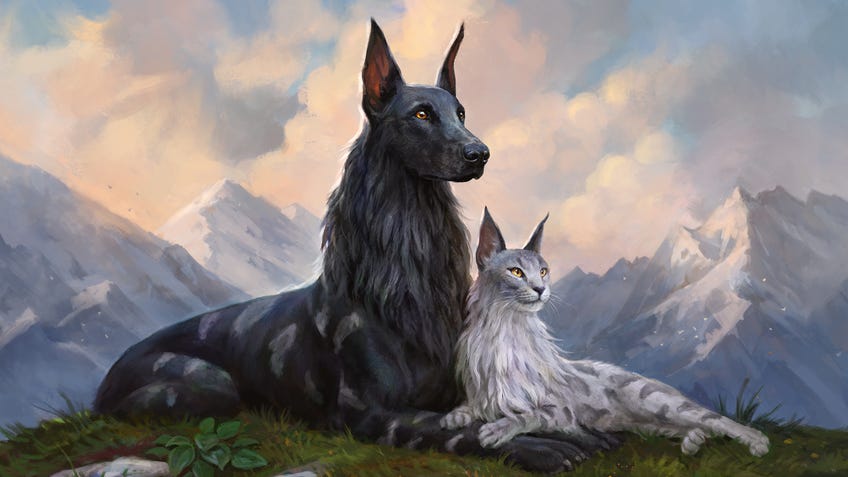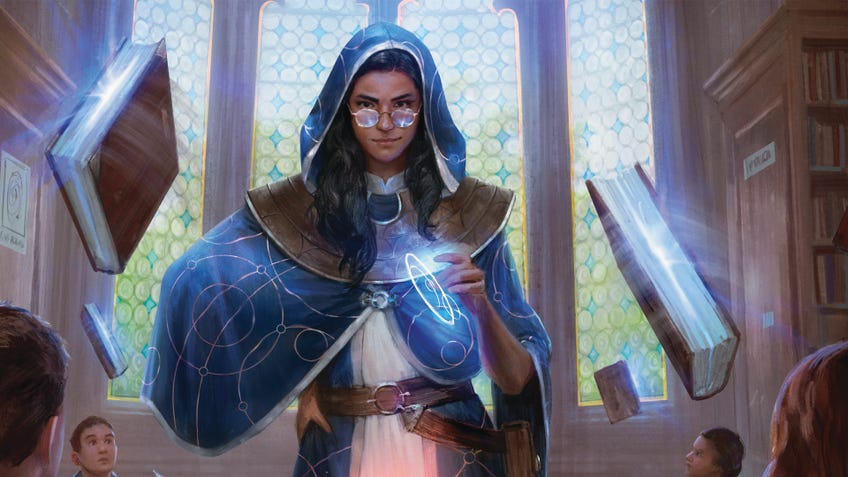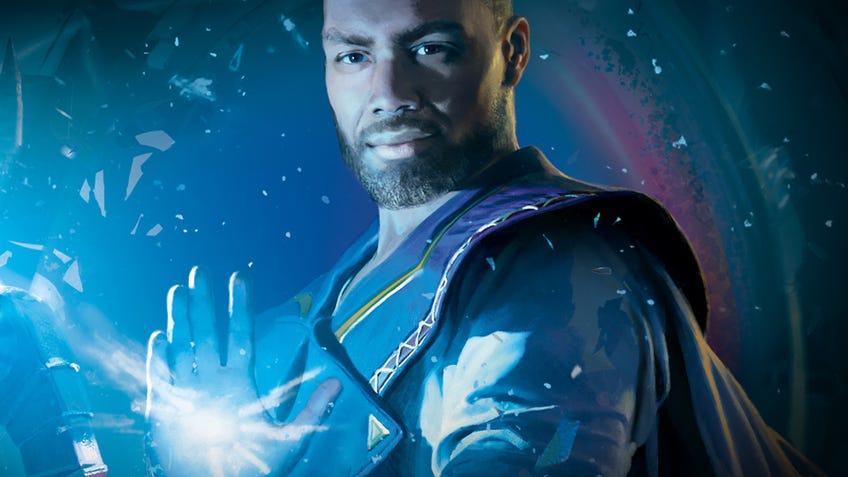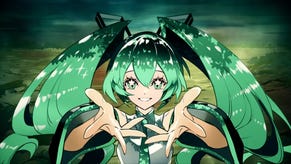Magic: The Gathering in 2021: Exhausting release cycle and skyrocketing prices pour cold water on game-changers
Too much of a good thing.
Magic: The Gathering has had an absurd year in 2021. This is largely detached from any ideas of good or bad - it's just a simple fact that we've had more MTG this year than any before it, and it's been harder to keep up with than ever. With the end of the year now upon us, it's the perfect time to look at what the year has been like on the whole, and what it could mean for MTG going forwards.
In terms of just Standard set releases, 2021 is possibly the first time in the history of MTG that we've had five sets in one year. Kaldheim, Strixhaven: School of Mages, Dungeons & Dragons: Adventures in the Forgotten Realms, Innistrad: Midnight Hunt and Innistrad: Crimson Vow all released this year.
Outside of Standard we've had Modern Horizons 2, Time Spiral Remastered and a slew of Commander decks alongside each of those releases. Modern Horizons 2 is possibly the best set we've had in the last few years, thanks to a strong mix of new cards and reprints which bolster the format. It's also an intensely powerful set, and has contributed to some of the highs and lows in MTG itself this year. This set, in particular, really highlighted the issues with the secondary market again. The new Commander deck idea is excellent though, leading to sets feeling more focused on the formats they're meant to support and parasitic mechanics like dungeons and foretell all having more options in the best format going.

While it's hard to believe there's any more than the seven sets we've already discussed, there have been a couple of MTG Arena-specific sets as well. Historic Anthology 5 was a rather minor addition, but Jumpstart: Historic Horizons added an obscene number of cards to the game. On one hand, it's nice to see so many new cards. On the other hand, it highlighted the issues MTG Arena has when it comes to its in-game economy, which still doesn't allow trading, dusting or crafting. Put simply, it sucks.
When there's always a new release on the horizon, how on Earth can any of us be expected to actually look forward to it?
All in all, that makes for nearly one new set a month this year - and that's not counting the various Secret Lair drops. It's an awful lot to deal with, and it's clear at this point that we're simply not meant to keep up with it. Aaron Forsythe, VP of design for MTG, talked to IGN and admitted that even he didn't recognise some cards that were played against him. He believes that trying to keep up with MTG now is as unrealistic as trying to watch every baseball game, despite that being an absurd analogy.
Forsythe’s words accurately sum up how a lot of us are feeling with our hobby at this point. With nearly one set every month comes a nonstop stream of spoilers and an expectation of hype. It used to be that a new MTG set was worth getting excited about, but when there's always a new release on the horizon, how on Earth can any of us be expected to actually look forward to it?
Instead - and this is mostly anecdotal - players have been stripping back how much MTG they're playing. After a full year of being locked inside, many were keen to get back out and play Magic with real people again. With the incessant marketing cycle, a lot of players have realised it's impossible to keep up with it all. Where a lot of players used to be active in multiple formats, some have just given up on doing so and decided to stick to just the one.
Nimble Pilferer is more expensive in MTG Online than in paper at one point, which is one of the most absurd MTG things of the year.
It's not just a time issue, either. Magic: The Gathering has always been expensive, but this year has shown off just how pricey it can be to stay on top of things. Modern is possibly one of the biggest offenders here, and it's largely due to a one-mana monkey.
Ragavan, Nimble Pilferer is a one-mana Red 2/1 that can be cast using dash for two mana. Dash is the ability that lets you put a card into play, give it haste and then have it come back to your hand at the end of the turn. Its ability reads: "Whenever Ragavan, Nimble Pilferer deals combat damage to a player, create a Treasure token and exile the top card of that player’s library. Until end of turn, you may cast that card." It's a good card, undoubtedly, but it's also currently sitting at around the £70 mark for a single. It was, in fact, more expensive in MTG Online than in paper at one point, which is one of the most absurd MTG things of the year.

This single Red card sits as a four-of in multiple Modern decks, with the average cost of each of those decks being around £1,100 - Ragavan alone contributing to a quarter of that cost. We all know MTG is expensive, it always has been, but something about this year seems to have made it more so. It's completely absurd to have to spend nearly £300 for four copies of a card that was released this year. Wizards of the Coast could absolutely change these prices by changing its own pricing, but it won't - and that’s going to stop players from getting involved in the more expensive formats.
The sets have been great, for the most part, but the cost of trying to keep up is becoming larger with each passing day.
If these formats can't be supported by more people then they are doomed to attract fewer players in tournaments. Which will, in turn, mean they get less support. It's simple enough, yet the issue hasn't been solved, and it doesn't look like it's going to be anytime soon.
It's frustrating because, from a card quality perspective, it's been a good year for MTG. The sets have been great, for the most part, but the cost of trying to keep up is becoming larger with each passing day.
January sees the release of Innistrad: Double Feature, a set that was sold to us as a curated collection of cards from Midnight Hunt and Crimson Vow, specially designed for drafts. The initial reaction to this was positive, as people love a good draft format and people really love Innistrad. That's not what the set actually is; it is, in fact, nearly every single card from both sets in one box, all of which has had a black-and-white filter applied to the artwork (and not a particularly good one at that). This probably isn't indicative of the future of MTG, but it is a disconcerting start to the new year.
Magic: The Gathering is changing at a rapid rate into something that feels more akin to Fortnite than a card game.
Next year will see the release of that along with Kamigawa: Neon Dynasty, Streets of New Capenna, Dominaria United and The Brothers War. Those are the Standard sets. We'll also be getting Unfinity, Commander Legends: Battle for Baldur's Gate, Double Masters, Jumpstart 2022 and the Warhammer 40,000 crossover product too. That is nine separate products - not including the Commander Collection in January, the new Commander decks and whatever extra stuff is going to come out.

Irrelevant of how much excitement there is for any of these sets individually, it seems we are once again going to be expected to either live in a constant state of excitement or just start to ignore anything that doesn't obviously cater to us. Magic: The Gathering is changing at a rapid rate into something that feels more akin to Fortnite than a card game. There's simply too much to do and no way to possibly keep on top of all of it, nor any way to realistically afford all of it.
We leave 2021, frankly, a little worried about MTG. The card quality remains high, and the sets can all be fun on their own, but the future of the game is wrought with too much. It's as though a monkey paw has curled in answer to those who wanted more MTG and now the game is almost impossible to keep up with - and next year looks to be even busier.










